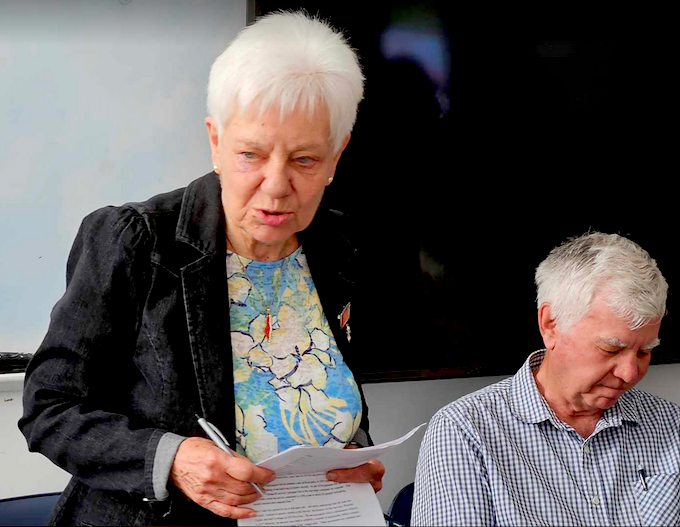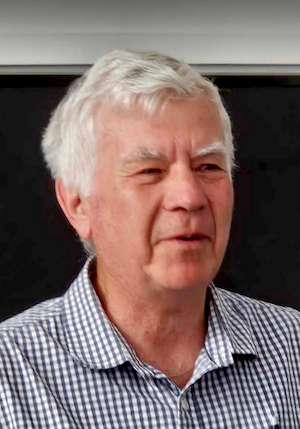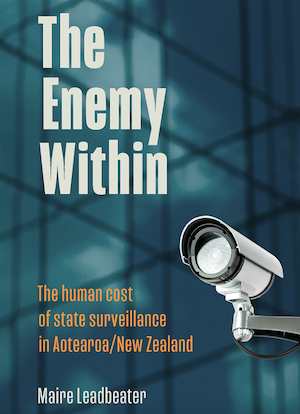
COMMENTARY: By Robert Reid
The Enemy Within, by Maire Leadbeater is many things. It is:
• A family history
• A social history
• A history of the left-wing in Aotearoa
• A chilling reminder of the origin and continuation of the surveillance state in New Zealand, and
• A damn good read.
The book is a great example of citizen or activist authorship. The author, Maire Leadbeater, and her family are front and centre of the dark cloud of the surveillance state that has hung and still hangs over New Zealand’s “democracy”.
What better place to begin the book than the author noting that she had been spied on by the security services from the age of 10. What better place to begin than describing the role of the Locke family — Elsie, Jack, Maire, Keith and their siblings — have played in Aotearoa society over the last few decades.
And what a fitting way to end the book than with the final chapter entitled, “Person of Interest: Keith Locke”; Maire’s much-loved brother and our much-loved friend and comrade.
In between these pages is a treasure trove of commentary and stories of the development of the surveillance state in the settler colony of NZ and the impact that this has had on the lives of ordinary — no, extra-ordinary — people within this country.
The book could almost be described as a political romp from the settler colonisation of New Zealand through the growth of the workers movement and socialist and communist ideology from the late 1800s until today.
I have often deprecatingly called myself a mere footnote of history as that is all I seem to appear as in many books written about recent progressive history in New Zealand. But it was without false modesty that when Maire gave me a copy of the book a couple of weeks back, I immediately went to the index, looked up my name and found that this time I was a bit more than a footnote, but had a section of a chapter written on my interaction with the spooks.
But it was after reading this, dipping into a couple of other “person of interest” stories of people I knew such as Keith, Mike Treen, the Rosenbergs, Murray Horton and then starting the book again from the beginning did it become clear on what issues the state was paranoid about that led it to build an apparatus to spy on its own citizens.
These were issues of peace, anti-conscription, anti-nuclear, decolonisation, unemployed workers and left trade unionism and socialist and communist thought. These are the issues that come up time and time again; essentially it was seditious or subversive to be part of any of these campaigns or ideologies.
Client state spying
The other common theme through the book is the role that the UK and more latterly the US has played in ensuring that their NZ client settler state plays by their rules, makes enemies of their enemies and spies on its own people for their “benefit”.

It was interesting to read how the “5 Eyes”, although not using that name, has been in operation as long as NZ has had a spying apparatus. In fact, the book shows that 3 of the 5 Eyes forced NZ to establish its surveillance apparatus in the first place.
Maire, and her editor have arranged this book in a very reader friendly way. It is mostly chronological showing the rise of the surveillance state from the beginning of the 19th century, in dispersed with a series of vignettes of “Persons of Interest”.
Maire would probably acknowledge that this book could not have been written without the decision of the SIS to start releasing files (all beit they were heavily redacted with many missing parts) of many of us who have been spied on by the SIS over the years. So, on behalf of Maire, thank you SIS.
Maire has painstakingly gone through pages and pages of these primary source files and incorporated them into the historical narrative of the book showing what was happening in society while this surveillance was taking place.
I was especially delighted to read the history of the anti-war and conscientious objectors movement. Two years ago, almost to the day, we held the 50th anniversary of the Organisation to Halt Military Service (OHMS); an organisation that I founded and was under heavy surveillance in 1972.
We knew a bit about previous anti-conscription struggles but Maire has provided much more context and information that we knew. It was good to read about people like John Charters, Ormand Burton and Archie Barrington as well more known resisters such as my great uncle Archibald Baxter.
Within living memory
Many of the events covered take place within my living memory. But it was wonderful to be reminded of some things I had forgotten about or to find some new gems of information about our past.

Stories around Bill Sutch, Shirley Smith, Ann and Wolfgang Rosenberg, Jack and Mary Woodward, Gerald O’Brien, Allan Brash (yes, Don’s dad), Cecil Holmes, Jack Lewin are documented as well as my contemporaries such as Don Carson, David Small, Aziz Choudry, Trevor Richards, Jane Kelsey, Nicky Hager, Owen Wilkes, Tame Iti in addition to Maire, Keith and Mike Treen.
The book finishes with a more recent history of NZ again aping the US’s so-called war on terror with the introduction of an anti and counter-terrorism mandate for the SIS and its sister agencies
The book traverses events such as the detention of Ahmed Zaoui, the raid on the Kim Dotcom mansion, the privatisation of spying to firms such as Thomson and Clark, the Urewera raids, “Hit and Run” in Afghanistan. Missing the cut was the recent police raid and removal of the computer of octogenarian, Peter Wilson for holding money earmarked for a development project in DPRK (North Korea).
When we come to the end of the book we are reminded of the horrific Christchurch mosque attack and massacre and prior to that of the bombing of Wellington Trades Hall and the Rainbow Warrior. Also, the failure of the SIS to discover Mossad agents operating in NZ on fake passports.
We cannot but ask the question of why multi-millions of dollars have been spent spying on, surveilling and monitoring peace activists, trade unionists, communists, Māori and more latterly Muslims, when the terrorism that NZ has faced has been that perpetrated on these people not by these people.
Maire notes in the book that the SIS budget for 2021 was around $100 million with around 400 FTEs employed. This does not include GCSB or other parts of the security apparatus.
Seeking subversives in wrong places
This level of money has been spent for well over 100 years looking for subversives and terrorists in the wrong place!
Finally, although dealing with the human cost of the surveillance state, the book touches on some of the lighter sides of the SIS spying. Those of us under surveillance in the 1970s and 1980s remember the amateurish phone tapping that went on at that time.
Also, the men in cars with cameras sitting outside our flats for days on end. Not in the book, but I have one memory of such a man with a camera in a car outside our flat in Wallace Street, Wellington.
After a few days some of my flatmates took pity on him and made him a batch of scones which they passed through the window of his car. He stayed for a bit longer that day but we never saw him or an alternate again.
Another issue the book picks up is the obsession that the SIS and its foreign counterparts had with counting communists in NZ. I remember that the CIA used to put out a Communist Yearbook that described and attempted to count how many members were in each of the communist parties all around the world.
In NZ, my party, the Workers Communist League, was smaller than the SUP, CPNZ and SAL, but one year near the end of our existence we were pleasantly surprised to see that the CIA had almost to a person, doubled our membership.
We could not work out why, until we realised that we all had code names as well as real names and we were getting more and more slack at using the correct one in the correct place. Anyone surveilling us, counting names, would have counted double the names that we had as members! We took the compliment.
Thank you, Maire, for this great book. Thank you and your family for your great contribution to Aotearoa society.
Hopefully the hardships and human cost that you have shown in this book will commit or recommit the rest of us to struggle for a decolonised and socialist Aotearoa within a peaceful and multi-polar world.
And as one of Jack Locke’s political guides said: “the road may be long and torturous, but the future is bright.”
Robert Reid has more than 40 years’ experience in trade unions and in community employment development in Aotearoa New Zealand. He is a former general secretary and president of FIRST Union. Much of his work has been with disadvantaged groups and this has included work with Māori, Pacific peoples and migrant communities. This was his address tonight for the launch of The Enemy Within: The Human Cost of State Surveillance in Aotearoa New Zealand, by Maire Leadbeater.







































